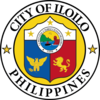
Iloilo, officially the Province of Iloilo, is a province in the Philippines located in the Western Visayas region. Its capital is the City of Iloilo, the regional center of Western Visayas. Iloilo occupies a major southeast portion of the Visayan island of Panay and is bordered by the province of Antique to the west, Capiz to the north, the Jintotolo Channel to the northeast, the Guimaras Strait to the east, and the Iloilo Strait and Panay Gulf to the southwest.

Malolos, officially the City of Malolos, is a 3rd class component city and capital of the province of Bulacan, Philippines. According to the 2020 census, it has a population of 261,189 people. It is the capital city of the province of Bulacan as the seat of the provincial government.

The Church of Saint Augustine, also known as the Archdiocesan Shrine of Our Lady of Consolation and Cincture or the Immaculate Conception Parish, is a Roman Catholic church under the auspices of the Order of Saint Augustine located inside the historic walled city of Intramuros in Manila, Philippines. Completed in 1607, it is the oldest stone church in the country.

Iloilo City, officially the City of Iloilo, is a 1st class highly urbanized city in the Western Visayas region of the Philippines on the island of Panay. It is the capital city of the province of Iloilo, where it is geographically situated and grouped under the Philippine Statistics Authority, but remains politically independent in terms of government and administration. In addition, it is the center of the Iloilo–Guimaras Metropolitan Area, as well as the regional center and primate city of the Western Visayas region. According to the 2020 census, Iloilo City has a population of 457,626 people. For the metropolitan area, the total population is 1,007,945 people.

Santa Barbara, officially the Municipality of Santa Barbara, is a 2nd class municipality in the province of Iloilo, Philippines. According to the 2020 census, it has a population of 67,630 people.
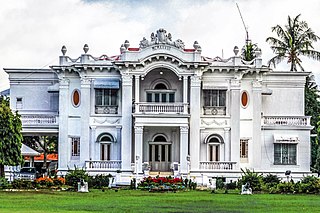
Jaro is a district in Iloilo City, Philippines, located on Panay Island in the Western Visayas region. It is the largest district in terms of both area and population, with 130,700 people according to the 2020 census. Jaro merged with Iloilo City in the 1940s during the American administration in the Philippines. It is also the largest among the seven districts of Iloilo City. La Paz district and the present municipalities of Leganes and Pavia were historically part of Jaro before becoming independent.

Molo is a district in Iloilo City, in Iloilo Province, on Panay Island in the Western Visayas region of the Philippines. It is the most densely populated district of all the seven districts of Iloilo City. It was originally a separate municipality before it became part of Iloilo through Act No. 719 of 1903. Molo's historical significance stems from its role as the Parián or Chinatown of Iloilo, where the Chinese residents of the city resided.
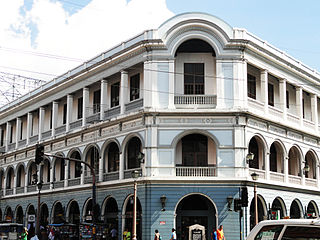
Iloilo City Proper is a district in Iloilo City, in the Western Visayas region of the Philippines. It holds great historical significance as the birthplace of modern-day Iloilo City and serves as a civic center, hosting the city and provincial government offices, as well as various local, provincial, and regional government establishments. The district also serves as the primary hub for financial institutions, with banks and other firms dispersed throughout its streets.

The Bacolod Public Plaza, officially the Plaza del 6 de Noviembre, named after the day of the Spanish surrender of Negros Island to the Negros revolutionaries, is one of the notable landmarks of Bacolod, the capital of Negros Occidental, Philippines. It is located in the heart of the downtown area, near the old city hall and across from the San Sebastian Cathedral. The plaza is a trapezoidal park with a belt of trees around the periphery and a gazebo at the center. Scattered within the trees are four circular fountains.

The Cebu Provincial Capitol is the seat of the provincial government of Cebu in the Philippines. Located at the north end of Osmeña Boulevard in Cebu City, it was designed by Juan M. Arellano, a Filipino architect best known for the Manila Metropolitan Theater (1935), the Legislative Building, and the Manila Central Post Office (1926). An inscription on the central concave portion of its façade reads, "The authority of the government emanates from the people. Erected A.D. MCMXXXVII."
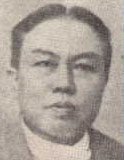
Antonio Ledesma Jayme was a Filipino lawyer, revolutionary hero, Governor of Negros Occidental, and assemblyman, as well as a lawmaker and a revolutionary nation's founding father and a signatory to a nation-state's constitution.

Ancestral houses of the Philippines or Heritage Houses are homes owned and preserved by the same family for several generations as part of the Filipino family culture. It corresponds to long tradition by Filipino people of venerating Ancestors and Elders. Houses could be a simple house to a mansion. The most common ones are the "Bahay na Bato". Some houses of prominent families had become points of interest or museums in their community because of its cultural, architectural or historical significance. These houses that are deemed of significant importance to the Filipino culture are declared Heritage House by the National Historical Commission of the Philippines (NHCP), previously known as the National Historical Institute (NHI) of the Philippines. Preservation is of utmost importance as some ancestral houses have come into danger due to business people who buy old houses in the provinces, dismantle them then sell the parts as ancestral building materials for homeowners wishing to have the ancestral ambiance on their houses. These ancestral houses provide the current generation a look back of the country's colonial past through these old houses.
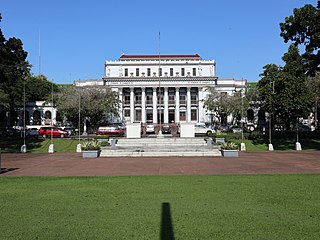
The Negros Occidental Provincial Capitol is the seat of the provincial government of Negros Occidental located at Gatuslao St., Bacolod, Philippines. Within its complex is the Capitol Park and Lagoon.

The President Carlos P. Garcia Heritage House is the residence of former Philippine President Carlos P. Garcia in Tagbilaran City, Bohol. It was declared as a heritage house by the National Historical Commission of the Philippines in 2009.

Casa Real is one of the oldest public buildings and served as the provincial seat of government of Lingayen, Pangasinan in the Philippines during the Spanish occupation in the country. It was where the Alcalde Mayor held office as the Provincial Governor and the Judge of the Court of First Instance. It was declared a National Landmark by the National Historical Commission of the Philippines and noted it as "an outstanding and unique example of civil architecture from the Spanish and American colonial periods". Local offices that were housed by the building abandoned it when Typhoon "Cosme" ripped off its roof in 2008. The provincial government of Pangasinan has already allotted funds for its renovation, which will turn it into a museum.
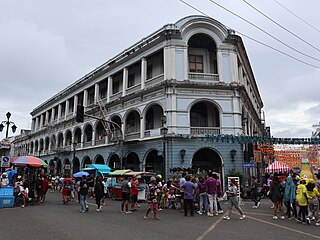
Calle Real, officially named as J.M. Basa Street, is a historic street located in the old downtown district Iloilo City Proper of Iloilo City, Philippines.The street often referred to as the "Escolta of Iloilo". It is home to several fine examples of historic luxury American era neoclassical, beaux-arts, and art deco buildings. The street has been famous since the Spanish Era. However, its importance has dwindled and the street has become less maintained; yet there have been efforts to revitalize the street, which include the restoration of the historic buildings along the street and beautification projects.
Philippines National Historic Landmarks is a registry of historic sites in the Philippines that have been officially declared by the Philippine Registry of Cultural Property.

The Governor of Iloilo is the local chief executive of the Philippine province of Iloilo. The governor holds office at the Iloilo Provincial Capitol located at Bonifacio Drive, Iloilo City. Like all local government heads in the Philippines, the governor is elected via popular vote, and may not be elected for a fourth consecutive term. In case of death, resignation or incapacity, the vice governor becomes the governor. Along with the governors of Aklan, Antique, Capiz, Guimaras and Negros Occidental, he sits in the Regional Development Council of the Western Visayas Region.

The Iloilo Provincial Capitol is the seat of the provincial government of Iloilo in the Philippines.

Arroyo Fountain is a historical landmark in Iloilo City, Philippines. It is located in front of Casa Real de Iloilo, or the Old Iloilo Provincial Capitol, in Iloilo City Proper. It was named after Senator José María Arroyo, who authored the law, Republic Act No. 3222, that established the then Iloilo Metropolitan Waterworks in 1925.





















